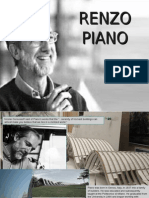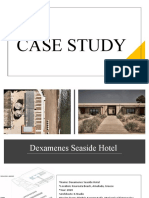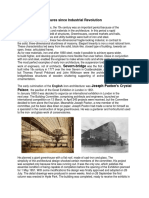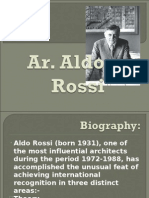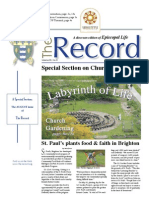Borneo Sporenburg
Borneo Sporenburg
Uploaded by
Dorin TecuceanuCopyright:
Available Formats
Borneo Sporenburg
Borneo Sporenburg
Uploaded by
Dorin TecuceanuOriginal Description:
Copyright
Available Formats
Share this document
Did you find this document useful?
Is this content inappropriate?
Copyright:
Available Formats
Borneo Sporenburg
Borneo Sporenburg
Uploaded by
Dorin TecuceanuCopyright:
Available Formats
Borneo Sporenburg,
Amsterdam (1993) 1996-1997
Architecture Almost sixty architects were involved in the developing of the main urban program. In workshops a collective manifest was created. Borneo Sporenburg seemed to offer the perfect condition for the innovative idea of the patio house with 30-50% void. In plan, the facades are designed with a minimum of street / quay exposition. Each house is designed around a void. Patios - Swiss cheese The master plan demanded a 30%-50% void in each of the individual homes. The architects were challenged to develop a typology in which a small patio served for day light penetration and personal outdoor space. This regulation created a series of new building typologies that suited the high density and back-to-back structuring of the houses. The 2.300 patios are the a domain for individual expression and privacy. Most of the patios make an indirect connection to the street and the quays. In the rough and open harbour landscape, the patios offer an unexpected and introverted world. These spaces refer to the 17th century paintings by Vermeer and Pieter de Hoogh. The sculptural blocks also enclose a collective void, courtyard or garden. Most of the patio facades are glass. The front doors are designed within the patio space. From the street, fences and gates lead to these front doors. The fences were part of the urban brief. Sphinx garden The sphinx block, with its narrow courtyard which is both interior and exposed, seemed to be the perfect condition for a poetic garden design. West 8 made a garden as a natural still life. The zinc facades of the building inspired to design six free-standing vases, 5.5m high out of zinc as well. These eloquent hand made vases are positioned on a surface of Norwegian slate, which reflect the silver grey fish skin zinc facades. The other part of the garden is in grass, blues vegetation (Hyrandgia) and tree shaped hedges. Seven large ginkgo trees contrast with the surreal botanic structure against the zinc facades. The courtyard has fences made of steel plates with a graphic pattern of ginkgo leaves. Public Space West 8 also made the design for the public space. To accommodate the variety of architecture and voids, the design for the streets and quays is kept to a minimum. Dutch brick paving and oversized concrete kerbstones is applied to straight and narrow streets. All the existing quay structures had been renovated. A diagonal green strip and two blue stone paved squares relate to the water. The quays will be colonised by the Armada of Amsterdam floating culture. This anarchy will vitalise the sterile 19th century docks. The water is the dominant public space green becomes blue. Two artists were asked by the Amsterdam Committee for Public Art to make an artwork in the plan. Free Parcels Instead of developers, individual landowners were given one of the nicest canals in the masterplan. The municipality sold sixty free parcels through the lottery. In 3x2 workshops all the clients and their architects were coached to a unique urban strip. Professional urban field and national planning authorities followed this initiative with great interest. The strip was an experiment to bring more influence to the landowners. This experiment which started in 1995 resulted in a contemporary equivalent of the canal house typology. In 1999 the plan was realised. Through supervision in each house a double high living (4-8m) facing the water was demanded. This proclamation of individuality became prototype for a radical new strategy in Dutch urban planning. In almost every new planned neighbourhood in the Netherlands free parcels will be integrated. Bridges Borneo Sporenburg has been built with 2500 dwellings (low-rise-high density). Three bridges connect the different neighbourhoods on the peninsulas and become the characteristic features for the development. The two bridges across the 93 meter wide basin have been designed as twins: one central low bridge for cyclists and disabled people and a 12 meter high bridge which provides access for sailboats to the marina in the basin. This high bridge reaches to a level from which the roof landscape become visible and offers a glimpse of the hidden
world of the patios and the panorama on the port. The two bridges have been constructed out of steel with an industrial red finish that is highlighted by the evening light. By welding the two bridges out of many small T-profiles the construction starts to form a skin which gives the bridge its sculptural image. The deck and railing of the bridge have been made out of robust untreated timber creating a dialogue with the industrial steel structure. The cast aluminium lights, shaped like the head of a seagull, hang on one side of the bridge and move with the changing cross section. The design gets it quality by recognition (the nineteenth century steel structure) and alienation. The bridges demand an active attitude. The high bridge with steep stairs provides the 'sitting' on the dock of the bay 'feeling', high above the water, away from the city.
You might also like
- Design Control&Modification Submission ProceduresDocument42 pagesDesign Control&Modification Submission ProceduresMarleneNo ratings yet
- Mehan Garden P1Document3 pagesMehan Garden P1Zianne CalubNo ratings yet
- Form and Space in Architectural MemorialDocument5 pagesForm and Space in Architectural MemorialAhins UpretiNo ratings yet
- Norman Foster Norman Foster Notable Projects: FactsDocument2 pagesNorman Foster Norman Foster Notable Projects: FactsXyra Airysh InandanNo ratings yet
- Food Forest EstablishmentDocument19 pagesFood Forest EstablishmentNathan Harder100% (1)
- Renzo PianoDocument20 pagesRenzo PianoRingo AlcaldeNo ratings yet
- INVE - MEM - 2012 - 200393 Roof Over A Roman SiteDocument4 pagesINVE - MEM - 2012 - 200393 Roof Over A Roman SiteHypermediaNo ratings yet
- Modern Design MagazineDocument100 pagesModern Design Magazineirna6im100% (1)
- Kaohsiung Centre For The Arts-Waves in The ParkDocument8 pagesKaohsiung Centre For The Arts-Waves in The ParkjoseNo ratings yet
- Contemporary ArchitectureDocument10 pagesContemporary ArchitectureTRILZ ARIS MILO ARREOLANo ratings yet
- Caf32 EngDocument40 pagesCaf32 EngCopperConceptNo ratings yet
- Renzo PIANODocument69 pagesRenzo PIANOAme HidalgoNo ratings yet
- Copper Forum: Magazine For Copper in The Construction Industry - 22 /2007Document40 pagesCopper Forum: Magazine For Copper in The Construction Industry - 22 /2007CopperConceptNo ratings yet
- Danish MuseumDocument12 pagesDanish Museumkshitij saojiNo ratings yet
- 10 Daring New Buildings Around The WorldDocument10 pages10 Daring New Buildings Around The WorldNandhini AashalNo ratings yet
- Caf37 Eng PDFDocument40 pagesCaf37 Eng PDFCopperConceptNo ratings yet
- Presentation Sainsburys3-FosterDocument57 pagesPresentation Sainsburys3-FosterFrancisco AlcazarNo ratings yet
- Metropol Parasol Case studyDocument7 pagesMetropol Parasol Case studyG16. Savannah FanerNo ratings yet
- 04122015-2 IGS Amazing Projects in GlassDocument14 pages04122015-2 IGS Amazing Projects in GlassJuandaCabreraCoboNo ratings yet
- Guggenheim BilbaoDocument11 pagesGuggenheim BilbaoSandra SamirNo ratings yet
- Hulumtimi I Projekteve NderkombetareDocument42 pagesHulumtimi I Projekteve NderkombetareRinor RushitiNo ratings yet
- Caf31 EngDocument40 pagesCaf31 EngCopperConceptNo ratings yet
- GFNFGN SFGN SFGNDocument13 pagesGFNFGN SFGN SFGNpauldasman1No ratings yet
- Chandigarh Urban Planner & Ar - Le CorbusierDocument18 pagesChandigarh Urban Planner & Ar - Le CorbusierLidhya Teslin Joseph100% (1)
- Capitol ComplexDocument9 pagesCapitol ComplexDeepika Reddy100% (1)
- 1430 KV Monterej Meksiko ASLA 2009Document5 pages1430 KV Monterej Meksiko ASLA 2009Dejan MotikaNo ratings yet
- European Copper in Architecture Awards 14Document12 pagesEuropean Copper in Architecture Awards 14CopperConceptNo ratings yet
- Fórum O Medi: Architecture FromDocument40 pagesFórum O Medi: Architecture FromCopperConceptNo ratings yet
- Iversity First ExamDocument4 pagesIversity First ExamPratishtha GargNo ratings yet
- Buliding Print 2472017Document16 pagesBuliding Print 2472017Dian Andriani LabiNo ratings yet
- Public Square LandscapesDocument146 pagesPublic Square LandscapesIoana ToniNo ratings yet
- Landscape Architects - James Corner and Antoni GaudiDocument13 pagesLandscape Architects - James Corner and Antoni GaudiShashank PatilNo ratings yet
- The Pritzker PrizeDocument4 pagesThe Pritzker PrizeLarisa Sotelo MéndezNo ratings yet
- Arjan02wigglesworthdone PDFDocument3 pagesArjan02wigglesworthdone PDFVuTienAnNo ratings yet
- CONTEMPORARYDocument10 pagesCONTEMPORARYTRILZ ARIS MILO ARREOLANo ratings yet
- Bimestral Eduardo Lozano Ingles 2Document14 pagesBimestral Eduardo Lozano Ingles 2Eduardo ValleNo ratings yet
- Palazzo Farnese and The Habitat '67Document5 pagesPalazzo Farnese and The Habitat '67Solo GathogoNo ratings yet
- Architional Notable BuildingsDocument277 pagesArchitional Notable BuildingsFredrick Sam ArellanoNo ratings yet
- Copper HarmonyDocument2 pagesCopper HarmonyCopperConceptNo ratings yet
- Frank Owen GehryDocument23 pagesFrank Owen GehryrishavNo ratings yet
- 5 The Most Unusual BuildingsDocument2 pages5 The Most Unusual BuildingsMariana RusuNo ratings yet
- Tampere Art Museum A Building History SurveyDocument30 pagesTampere Art Museum A Building History SurveyppingNo ratings yet
- Amsterdam-Town Planning Report - Bhanu KhannaDocument58 pagesAmsterdam-Town Planning Report - Bhanu KhannaBhanuKhanna100% (4)
- French Museum ArchitectureDocument174 pagesFrench Museum ArchitectureefervidacienciaNo ratings yet
- Zaha HadidDocument14 pagesZaha HadidMridusmita MondalNo ratings yet
- Case StudyDocument30 pagesCase StudyAnjaliNo ratings yet
- Mod 1Document22 pagesMod 1NANMA ZAKKEERNo ratings yet
- Industrial LandscapeDocument39 pagesIndustrial LandscapeDina Hawash50% (2)
- Famous ArchitectsDocument28 pagesFamous ArchitectsNathanniel Alfonso100% (1)
- PRESENTAION On Architect Mies Van Der RoheDocument74 pagesPRESENTAION On Architect Mies Van Der RoheAshish HoodaNo ratings yet
- Aldo RossiDocument35 pagesAldo RossiShiva Kumar SNo ratings yet
- 12 - Jagtap - Hritika - Post ModernismDocument9 pages12 - Jagtap - Hritika - Post ModernismHritika JagtapNo ratings yet
- Centre PompidouDocument3 pagesCentre PompidouAllaa Harraky100% (1)
- Architect Laurie BakerDocument116 pagesArchitect Laurie BakerSuvarna456100% (5)
- Pérez Art Museum MiamiDocument8 pagesPérez Art Museum MiamiTheodora PatsNo ratings yet
- Wood in LandscapingDocument51 pagesWood in Landscapingd-fbuser-25117687100% (7)
- 17 Architecturally Amazing MuseumsDocument42 pages17 Architecturally Amazing MuseumsBeatrice GhermanNo ratings yet
- Ardec05brendeland PDFDocument1 pageArdec05brendeland PDFVuTienAn100% (1)
- An Art-Lovers Guide to the Exposition Explanations of the Architecture, Sculpture and Mural Paintings, With a Guide for Study in the Art GalleryFrom EverandAn Art-Lovers Guide to the Exposition Explanations of the Architecture, Sculpture and Mural Paintings, With a Guide for Study in the Art GalleryNo ratings yet
- The Brochure Series of Architectural Illustration, Volume 01, No. 05, May 1895 Two Florentine PavementsFrom EverandThe Brochure Series of Architectural Illustration, Volume 01, No. 05, May 1895 Two Florentine PavementsNo ratings yet
- Proposed Memorial ParkDocument18 pagesProposed Memorial ParkArbie Magcalas DoronilaNo ratings yet
- Casestudy IP HighlightedDocument25 pagesCasestudy IP HighlightedMisty100% (1)
- Analysis Saif Anas MohammadDocument159 pagesAnalysis Saif Anas Mohammadعمر رائد مشتهى احمدNo ratings yet
- Hort. 4.4 Production Technology For Ornamental Crops, Maps and Landscaping (1+1)Document62 pagesHort. 4.4 Production Technology For Ornamental Crops, Maps and Landscaping (1+1)Dr.Ranchana 2243100% (1)
- Suddhodhan ReportDocument34 pagesSuddhodhan ReportRiya ShresthaNo ratings yet
- Ccaaguide2003 t49 Res Floors Web TBRDocument47 pagesCcaaguide2003 t49 Res Floors Web TBRLaura KinnearNo ratings yet
- Water As A Major Landscape ElementDocument2 pagesWater As A Major Landscape ElementShubhaNo ratings yet
- Needham Odd/Even Non-Essential Water Use RestrictionDocument4 pagesNeedham Odd/Even Non-Essential Water Use RestrictionGrahame TurnerNo ratings yet
- Final Vertical Green Habitat DissertationDocument53 pagesFinal Vertical Green Habitat DissertationEkansh SharmaNo ratings yet
- Charter For Conservation of Historic Garden 1981Document35 pagesCharter For Conservation of Historic Garden 1981ayeshazahid546No ratings yet
- Landscape Introduction Site AnalysisDocument56 pagesLandscape Introduction Site Analysisyusuf stephenNo ratings yet
- Henri Martin Paintings For ReproductionDocument410 pagesHenri Martin Paintings For ReproductionPaintingZNo ratings yet
- Planting The Landscape: Jose B. Juson, JRDocument34 pagesPlanting The Landscape: Jose B. Juson, JRRobert AguilarNo ratings yet
- Trees & Plants - SOIL EROSION: Landscape ArchitectureDocument22 pagesTrees & Plants - SOIL EROSION: Landscape ArchitectureCapao Padilla100% (1)
- Landscape Ke Notes HonDocument44 pagesLandscape Ke Notes HonfizzaNo ratings yet
- Apartment Gardening PDFDocument106 pagesApartment Gardening PDFazkkr80% (5)
- RC 6Document22 pagesRC 6tenkiNo ratings yet
- Visite Rosmarino - AnglaisDocument3 pagesVisite Rosmarino - AnglaisRoberto BigliaNo ratings yet
- Japanese Garden - LandscapeDocument15 pagesJapanese Garden - LandscapePriya Verma100% (1)
- Presentation (2) ROOFTOP Assignment No 04Document4 pagesPresentation (2) ROOFTOP Assignment No 04Ravindu LakshanNo ratings yet
- IntegrityDocument3 pagesIntegrityapi-754013304No ratings yet
- Village Health Works Hospital in Burundi PDFDocument7 pagesVillage Health Works Hospital in Burundi PDFGerman David ElstonNo ratings yet
- Ene 5170 Final Project - 4 15 2019Document35 pagesEne 5170 Final Project - 4 15 2019api-469886140No ratings yet
- Apartment Gardening Ebook PDFDocument94 pagesApartment Gardening Ebook PDFGerard CoNo ratings yet
- Andre Le NotreDocument22 pagesAndre Le NotreAnirban ThakurNo ratings yet
- Church Gardening, The RecordDocument7 pagesChurch Gardening, The RecordAoede ArethousaNo ratings yet






